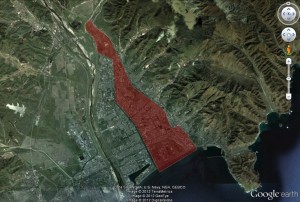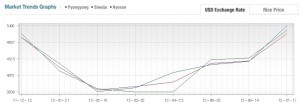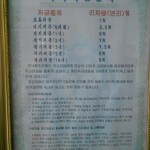Prosecutors carried out a large-scale investigation of companies involved in inter-Korean trade over the past year. They were seeking evidence of violations of the Inter-Korean Exchange and Cooperation Act (IKEC Act) in their remittances to North Korea. Around 200 such companies were found to have been fined.
The fined companies argue that their penalties are attributable to differing interpretations and application of the law by the Lee Myung-bak administration. The same actions were not deemed problematic under the administrations of Kim Dae-jung and Roh Moo-hyun (1998-2008). Those governments took a softer line on North Korea; things changed significantly when the conservative Lee Myung-bak government took office in 2008.
The Inter-Korean Economic Cooperation Promotion Committee, under chairman Jeong Yang-geun, estimated that as many as 200 companies involved in inter-Korean trade had been fined as of late May. A biggest change was the Lee government’s May 24 measures, put in place after the March 2010 sinking of the Cheonan warship. The measures suspended almost all transactions with North Korea.
Companies that were already on the brink of bankruptcy were stuck with fines ranging from one million to eight million won. Companies with high transaction volumes were fined the legal limit of 10 million won (about US$8500).
They were accused of violating Article 13, Item 1 of the Exchange and Cooperation Act, citing Article 4 of a Jan. 2008 Unification Ministry notice stating that anyone sending a third-party remittance to North Korea through a Chinese bank account must receive separate permission from the Unification Minister.
The president of Company “H,” identified by the initial “K,” has been called and visited several times since late last year by police public security officers and detectives from in and around Seoul and elsewhere investigating items brought in from North Korea. In April, he was summoned to a police station in South Gyeongsang province.
K had been involved in transactions since before the Kim and Roh administrations. He said there were no problems because the items in question were subject to blanket approval by the Unification Minister and had already passed through normal procedures.
The president of Company T, identified as Lim, was investigated on the same charge between January and April of this year. He confessed being cowed by the demand to travel from Seoul to a police station in Incheon and report to the security division there. He said he wasted time and suffered hardship submitting three rounds of documentation at the police’s request. Five companies had already been investigated by that same police station, Lim said.
“The police asked for an authoritative interpretation, and the officials at the Unification Ministry couldn’t make a proper judgment about whether there had been a violation. It was as though they had no idea such a rule existed,” he added.
The president of Company C, who goes by the initial “G,” paid a visit to Korea Exchange Bank in late 2007 to send a remittance to pay for sand, and was told that a third-party remittance was not possible. G went to the Bank of Korea. There, he was told they wouldn’t be able to do a remittance either. So he put one of the employees there in touch with the Unification Ministry. After that, he was able to notify the Bank of Korea and send remittances within their limit without a problem.
Some time around March of 2011, police launched an investigation and began calling him in. He asked them just what kind of permission he was supposed to receive. There was no information in the Jan. 2008 ministry notice about the procedure or documents for remittances. He also asked what kind of law for exchange and cooperation the IKEC Act was. G was fined according to another law after lawfully sending the remittance according to the Foreign Exchange Transactions Act.
Experts and attorneys countered that the transactions in question were already approved according to Article 13, Item 4 of the IKEC Act, which empowers the Unification Minister to issue blanket approvals to “items involved in transactions with North Korea, forms of transactions, and methods of payment.” And since North Korea does not have an international financial system, nearly all the companies’ remittances took the form of third-party transactions through Chinese banks.
Experts and attorneys said the fines could only be interpreted as prosecutors taking issue with the very notion of money being sent to North Korea. The businesspeople in question had also agreed with the ministry to follow a normal procedure of reporting third-party remittances to the Bank of Korea in accordance with the Foreign Exchange Transactions Act, they said.
An attorney for Corporation “T” said, “Not only is there ample room for debate about judicial authorities punishing activities deemed lawful by Article 13, Item 4 of the IKEC Act on the basis of the Unification Minister’s notice, but it also shows a disregard for what the ministry has recognized over the past years.”
Indeed, a trade company sent a question to the ministry asking whether any of the 500 firms it knew to be involved in inter-Korean economic cooperation had requested approval from the minister for third-party remittances to North Korea. None, the ministry replied.
The ministry was also found not to have taken any follow-up measures on documentation or procedures in its presiding offices after specifying in its notice that the minister’s approval was required for third-party remittances.
University of North Korean Studies professor Yang Mu-jin, a onetime secretary to the Unification Minister, said, “After the May 24 measures, now they’re killing these businessmen twice.”
But a senior ministry official said there was no problem with application of the law in the prosecutors’ investigation, although it was done without prior discussion with the ministry.
Another senior official said the notice was issued “in the interest of ensuring transparency in remittances to North Korea.”
Those on the receiving end of the fines said the measures were tantamount to using the Exchange and Cooperation Act to kill off the companies involved in exchange and cooperation.
“They’re about to keel over anyway because of the state inter-Korean relations are in,” one said. “What good is the law once all the companies are gone?”
Unification Ministry figures show a steady increase in the amount of North Korean items brought in through inter-Korean trade (including consignment processing), rising from US$258 million win 2004 to a peak of US$645 million in 2007. The level stayed above US$600 million as recently as 2008, the first year of the Lee administration.
But as relations with North Korean headed downhill, the numbers plummeted below US$500 million starting in 2009, finally bottoming out at US$4 million in 2011 after relations were severed with the May 24 measures.



